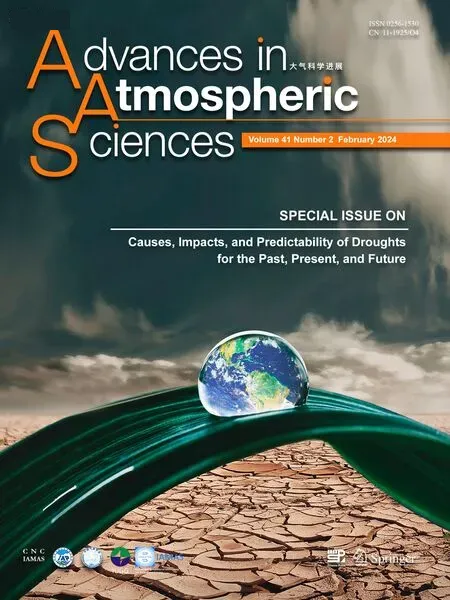Preface to the Special Issue on Causes,Impacts,and Predictability of Droughts for the Past,Present,and Future※
Tianbao ZHAO,Aiguo DAI,Jianping HUANG,and Lixia ZHANG
1Key Laboratory of Regional Climate-Environment Research for Temperate East Asia, Institute of Atmospheric Physics (IAP), Chinese Academy of Sciences (CAS), Beijing 100029, China
2Department of Atmospheric and Environmental Sciences, University at Albany, SUNY, Albany, New York 80307, USA
3Key Laboratory for Semi-Arid Climate Change of the Ministry of Education, Lanzhou University, Lanzhou 730000, China
4State Key Laboratory of Numerical Modeling for Atmospheric Sciences and Geophysical Fluid Dynamics (LASG),Institute of Atmospheric Physics, Chinese Academy of Sciences, Beijing 100029, China
Drought is a recurring dry condition with below-normal precipitation and is often associated with warm temperatures or heatwaves.A drought event can develop slowly over several weeks or suddenly within days,commonly under abnormal atmospheric conditions (e.g.,quasi-stationary high-pressure systems),and can persist for weeks,months,or even years,often exerting great socioeconomic impacts.The consequences of drought are far-reaching,impacting water quality and supply,public health,food security,and the natural environment.Increasing evidence suggests that greenhouse gas-induced global warming can lead to more frequent,severe,and long-lasting droughts,due to ubiquitous increases in evaporative demand under rising temperatures and decreased precipitation over subtropical areas.Meanwhile,population growth and associated increases in agricultural and industrial activities also strengthen the demand for freshwater resources,potentially increasing drought risk.Thus,there has been considerable concern around the increased drought risk as global warming continues.While many studies have addressed the increased risk of drought in the 21st century,more efforts are needed to fully analyze and understand droughts in the past,present,and future under a changing climate.
We organized this special issue to focus on analyzing the drought risk under a warming climate,understanding drought formation mechanisms,and examining the attribution,prediction,and projection of drought.The collection of publications on these topics in this special issue will facilitate the synthesis of new research results,identify key scientific gaps,and hence contribute to a more thorough understanding of drought changes and variability under a changing climate.This special issue presents new scientific evidence and insightful findings on the historical changes and future projections of drought at global and regional scales.The major contributions are summarized as follows:
Globally,Yu et al.(2024) show that the observed increasing trends in drought fractional area,occurrence,and corresponding meteorological anomalies during 1980-2014 are reasonably reproduced by CMIP6 models,while mild and moderate droughts are underestimated after the late 1990s as natural variability in the real world is absent in the CMIP6 ensemble mean.Due to a weaker response of dryland drought changes to global warming in CMIP6 models,it is imperative to employ bias correction approaches in drought-related studies over drylands when using CMIP6 outputs.Black (2024)reports that the frequency of both upper-level and root-zone flash drought is projected to more than double in the mid-and high-latitudes over the 21st century,with hotspots developing in the temperate regions of Europe and humid regions of South America,Europe,and southern Africa.
In China,Wu et al.(2024) reveal that the spatiotemporal changes in dry/wet conditions are asymmetric in eastern and western China during the last 100 years.Su et al.(2024) conclude that the frequency and duration of observed concurrent hot and dry events over China during the growing season (April-September) exhibit significant decadal changes around the mid-1990s.More specifically,they establish that the frequency of hot and dry events averaged over China during recent years (1994-2011) is twice that in the early period (1964-1981),with a 60% increase in the duration of hot and dry events.These observed decadal changes of 60%-70% are likely due to anthropogenic forcing associated with increases in greenhouse gas concentrations.
In the Umatilla river basin,Gautam et al.(2024) utilized downscaled CMIP5 multimodel simulations to suggest that short-duration meteorological,hydrological,and agricultural droughts will all become more frequent,with an increase of around 20%,11%,and 28% in frequency,respectively,from 2030-2059 to 2070-2099,together with longer drought durations under the moderate-higher emissions scenario.The decrease in future drought propagation time will likely stress the timing and capacity of water supply in the basin for irrigation and other uses.
 Advances in Atmospheric Sciences2024年2期
Advances in Atmospheric Sciences2024年2期
- Advances in Atmospheric Sciences的其它文章
- Record-breaking High-temperature Outlook for 2023: An Assessment Based on the China Global Merged Temperature (CMST) Dataset
- Impact of Sky Conditions on Net Ecosystem Productivity over a “Floating Blanket” Wetland in Southwest China
- Circulation Pattern Controls of Summer Temperature Anomalies in Southern Africa
- Attribution of Biases of Interhemispheric Temperature Contrast in CMIP6 Models
- The Spatiotemporal Distribution Characteristics of Cloud Types and Phases in the Arctic Based on CloudSat and CALIPSO Cloud Classification Products
- Impacts of Ice-Ocean Stress on the Subpolar Southern Ocean:Role of the Ocean Surface Current
